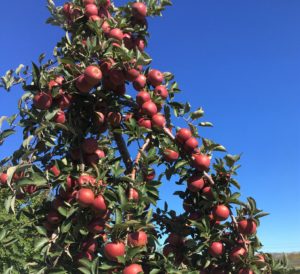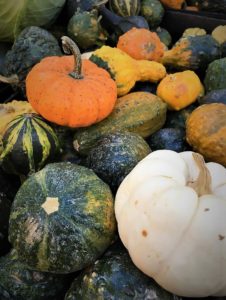Late October is a wonderful time to visit the fruit stands. Several varieties of apples are still being harvested. All kinds of citrus are arriving at the market.
I love apples but eat them almost exclusively during the harvest season. Of course, I understand that freshly harvested produces are more nutritious. But, I must confess that I only eat apples while they are in season because I am a picky eater.
There was no cultivation of apples in Taiwan when I was little. The imported Red Delicious were the best kind on the market. Occasionally, we would get them as special treats. Sometimes when we were sick, mom would use a spoon to scrape up the pulp in small servings for us. Gradually, crops from central mountain region became popular. The fruits were small and slightly tart but very flavorful. Their crisp texture won me over.
While living in the Midwest, I always wanted to join friends when they went apple picking but never did make it. The freshly picked fruits that they brought home, however, taught me the lesson of eating local and eating in season. There was no turning back for me.
One autumn day, I came home to find a basket of apples on the table. Mom took a walk around the neighborhood when I was at work and noticed the apple tree at the edge of the country club across the road from us. She thought it was a wasteful thing that people just left the apples on the ground. So, she went back and collected them. We made an apple pie! But, I had to tell mom not to collect anything from other people’s property again.

I first tasted Honeycrisp around 2005. I not only fell in love with the variety but also became very interested in the genetic origins of apples. Every time I saw a variety that I hadn’t tasted before, I would try it and search its origin—just to see if it might be related to any popular varieties. My latest find was Lady Alice, an old breed but new to my palate. It was a “chance seedling,” a creation of nature—opposite of Honeycrisp, an invention of mankind. Lovely to imagine how it happened long, long ago.
I love baking with apples. And, when possible, I would mix a few varieties for more complex flavors. Knowing the quality of each variety would become part of my preparation: a game of balance. The possibilities will never end.
The forbidden fruit of Eden, apples are symbols of peace and in Chinese culture (蘋=平). They are often paired with oranges, symbols of luck, as celebratory fruits for New Years and other happy occasions. So, my childhood memories of orange are always linked with cold winter days and the sounds of firecrackers.
草山橘 (Tsao-shan citrus) was a variety grown on the hills of Yangmingshan (陽明山), right outside of Taipei city. Their size was very child-friendly. And, they are very juicy. However, they are very hard to peel. I would always ask an adult to help me removing part of the peel first. Peeling and eating orange was one of my procrastinating tricks—especially, to delay my piano practice. I would peel the fruits slowly and separate each segment. I would, then, peel of the membrane and the white stringy stuff one little bit at a time. It could take me a LONG time to finish one orange. This strategy drove mom crazy. Sometimes, she would have to take the fruit away from me, so I would move on to the next thing.
Oranges remain high on my list of favorite fruits. But, I didn’t really know the flavor of orange until the first time I cut open an “Arancia Rossa di Sicilia.” The ruby red flesh surprised me. The intense citrusy taste woke up my taste buds instantly. At the moment, I was able to relate to Mignon, the character in Goethe’s Wilhelm Meister’s Apprenticeship. Having been abducted by Gypsies, she sang about her native land, Italy:
Kennst du das Land, wo die Zitronen blühn,
Im dunkeln Laub die Gold-Orangen glühn,
Ein sanfter Wind vom blauen Himmel weht,
Die Myrte still und hoch der Lorbeer steht?
Kennst du es wohl?
Dahin! dahin
Möcht’ ich mit dir, o mein Geliebter, ziehn.
(Do you know the land, where the citruses bloom,
Among dark leaves, the golden oranges glow,
A soft wind wafts from the blue sky,
The myrtle stands silently, and the laurel tree grows tall?
Do you know it well?
To there, with you, my beloved, I want to travel.)
Although I didn’t completely abandon other types of citrus fruits, from that moment on, I was always drawn to blood oranges. Before it became commonly available, some of my friends and students would be surprised to see me eating bloody looking fruits. Most of them appreciated my choice after one taste.
Apples and oranges bring colors and flavors into my kitchen and my life.
Curious about apple varieties, their characters, textures, and tastes?
Directory of apple varieties

